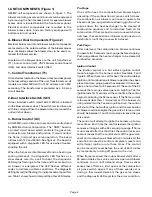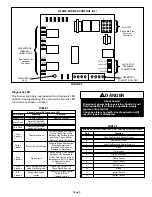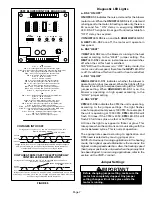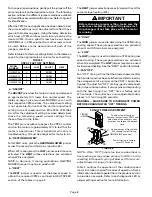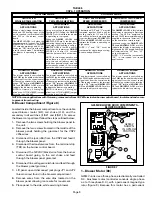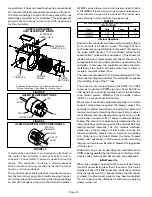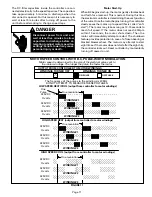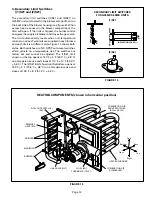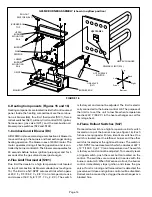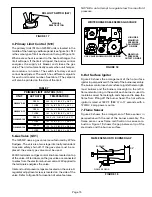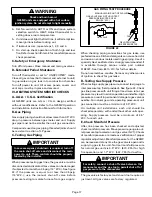
Page 4
I–UNIT COMPONENTS (Figure 1)
G25MV unit components are shown in figure 1. The
blower controls, gas valve and burners can be accessed
by removing the front access panel. A separate blower
access door is located behind the front access panel.
Electrical control components are mounted to the
blower access door. Units are factory equipped with
bottom return air panels
A–Blower Door Components (Figure 2)
Electrical burner control and blower control components
are located on the outside surface of the blower access
door. Jackplugs allow the blower door to be easily re-
moved for blower service.
Located on the blower door are the unit transformer
(T1), burner control (A3), VSP2 blower control board
(A24), and door interlock switch (S51).
1– Control Transformer (T1)
A transformer located on the blower door provides power
to the low voltage section of the unit. Transformers on all
models are rated 50VA with a 120V primary and a 24V
secondary. The transformer is protected by a 3.0 amp
circuit breaker.
2–Door Interlock Switch (S51)
A door interlock switch rated 16A at 125VAC is located
on the blower access door. The switch is wired in series
with line voltage. When the blower door is removed the
unit will shut down.
3– Burner Control (A3)
All G25MV units utilize a burner control manufactured
by RAM Electronics Corporation. The “RAM” board is
a printed circuit board which controls the gas valve,
combustion air blower and ignition. It also monitors
the flame, limit and gas valve operation. The board
utilizes both 120 and 24VAC. See figure 3. The board is
equipped with a diagnostic LED for use when trouble-
shooting the unit.
When the furnace is idle (blower off and no heating or
cooling demand), the diagnostic LED flashes at a
slow steady rate. On a call for heat, the diagnostic
LED begins flashing at a fast rate and the combustion
air blower is energized. The LED flashes different
codes to indicate problem conditions. The diagnostic
LED lights red (not flashing) to indicate control board fail-
ure. Table 1 shows how to interpret the other LED modes.
Pre-Purge
On a call for heat, the combustion air blower begins
operating. If the combustion air prove switch closes,
the combustion air blower continues to operate for
30 seconds (pre-purge) before allowing ignition. Pre-
purge allows the heat exchanger to be cleared of
combustion products and to introduce fresh air for
combustion. If the combustion air prove switch does
not close, the combustion air blower continues to run
indefinitely (until the prove switch closes).
Post-Purge
After a demand, the combustion air blower continues
to operate for 5 seconds (post-purge) before stopping.
Post-purge allows the heat exchanger to be cleared of
combustion products.
Ignition Control
The ignition control is a hot surface ignition control
module integral to the burner control. See table 2 and
figure 3. When there is a call for heat, the control delays
ignition until combustion air blower operation has been
proved and pre-purge period has elapsed. It then ener-
gizes a hot surface for 35 seconds. At the end of the 35
seconds the main gas valve opens on high fire. Trial for
ignition lasts for 7 seconds. At the same time, the control
begins monitoring the flame sensor. If the flame current
is too weak (less than 1 microamp) or if the burners do
not ignite (within the 7 second ignition trial), the control
will shut off the hot surface ignitor and the combustion
air blower and de-energize the gas valve. Flame current
should be between 1 and 5 microamps to keep the gas
valve open.
The control will attempt to ignite the burners up to two
more times. Each time the control restarts the ignition
sequence, it begins with a 30 second pre-purge. If flame
is not sensed after the third trial, the control locks out.
Lockout means that the control shuts off the gas valve,
spark and combustion air blower for 60 minutes. At the
end of 60 minutes the control completely resets and
will attempt ignition up to three times. The control
can be manually reset before the end of 60 minutes
by momentarily turning off power to the unit.
When flame is sensed, the indoor blower starts after a
45 second delay. Gas valve remains open and blower
continues to run until demand stops, flame sensor
senses loss of flame, a limit opens or the combustion
air prove switch opens. If any of these events occur
during a thermostat demand, the gas valve closes
and the diagnostic LED registers the error condition.




